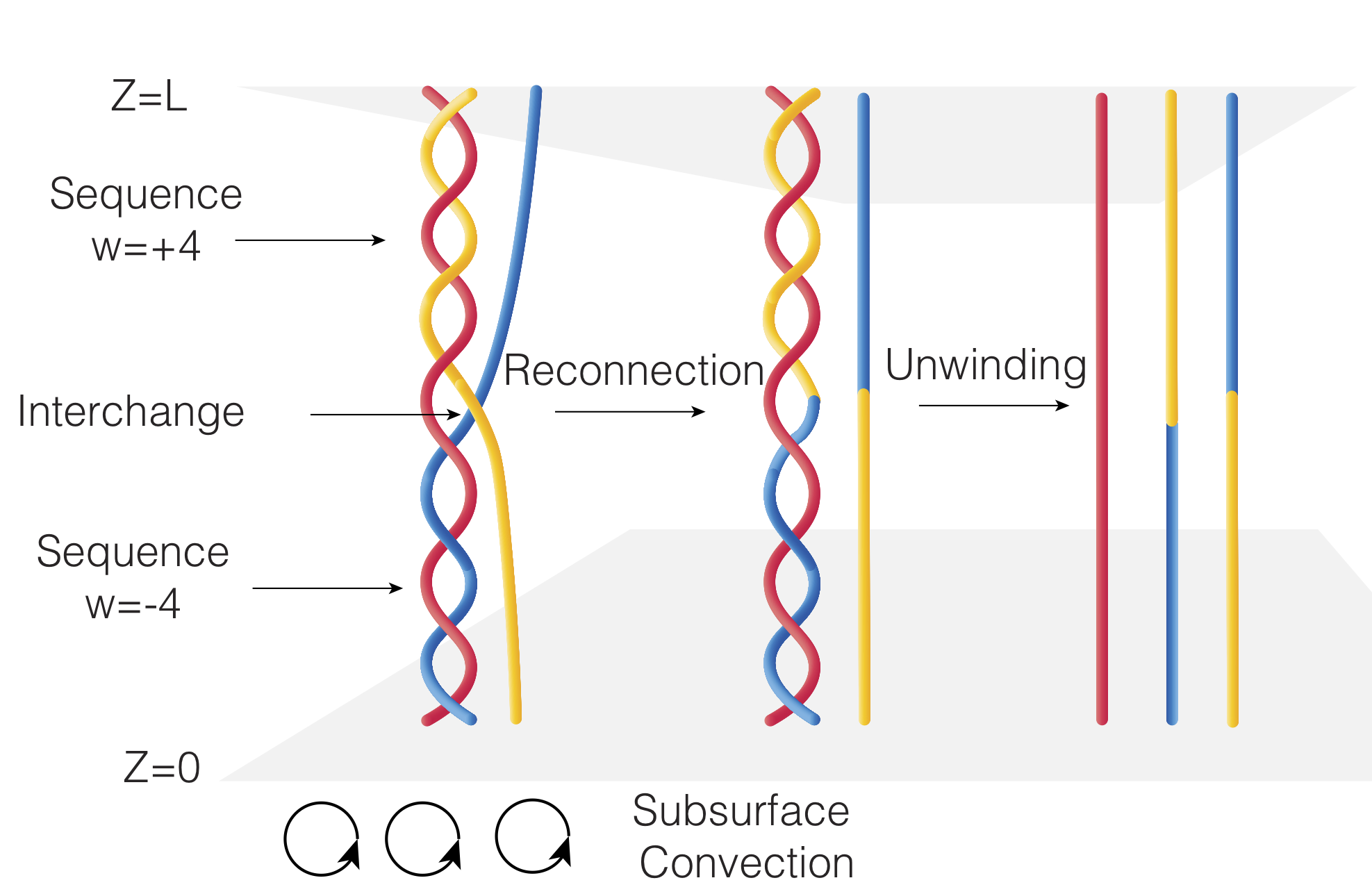Here is a poster about these papers for Cool Stars 21.
The theory of self-organized criticality describes a class of dissipative dynamical systems which remain at a critical point with no intrinsic length or time scale. The existence of the critical state requires a local instability, which occurs when some parameter exceeds its critical value and results in a dissipative transport process where this same parameter increases at neighboring sites. A simple physical analogy is a sand pile. As sand particles are added, the difference in height between neighboring sites on the pile increases. When the additional sand particles make the new height difference exceed a critical threshold, avalanche events occur. This system maintains a critical slope, representing a dynamical attractor that is insensitive to the initial conditions. This critical state is maintained via nonlinear avalanche events spanning all length scales triggered by perturbations. Click on the image below for a full video!
The theory of self-organized criticality has successfully described nonlinear dynamical phenomena such as the featureless temporal energy spectrum of earthquakes and solar flares. This implies that the solar coronal magnetic field maintains itself in a critical state, via a delicate balance between the dynamo-driven injection of magnetic energy and the release of that energy into the solar wind. As a result, it is natural to hypothesize that other stars in our galaxy, which undergo similar flaring events, maintain self-organized critical states in their coronae. To date, this has proven difficult to test because of the lack of observational data and the difficulty in identifying low amplitude flaring events to fill-out the energy spectrum. For the first time, the combination of NASA's all-sky high-cadence Transiting Exoplanet Survey Satellite (TESS) data and novel machine learning techniques have made testing this hypothesis feasible.
In our new paper, Testing Self-Organized Criticality Across the Main Sequence using Stellar Flares from TESS, we use a combination of broadband observational data from TESS and newly developed neural networks to detect flares to provide empirical evidence that all stellar coronae, independent of mass and evolutionary stage, may be in self-organized critical states. If this proves to be true, then we will be able to infer properties of magnetic fields, interior structure, and dynamo mechanisms for unresolved stars across the galaxy. Moreover, there is predictive power for flaring events, which will have ramifications for the atmospheric dynamics of close-in, readily detected, transiting extra-solar planets.
HR Diagram showing all the stars in our sample and their flare rates
The flair frequency distributions for the stars in our sample organized by stellar mass.
In our recent paper, Seligman et al. ApJ, Under Review, 2022, we present a theoretical model in which coronal magnetic fields braid, reconnect, and produce a shallower distribution of flare energies in stars that rotate more rapidly (corresponding to a weaker decline in occurrence rates toward increasing flare energies), and tentative evidence for the predicted rotation-power-law index correlation in TESS observations of flaring events.
A schematic diagram of three braided flux tubes that cause an incoherent reconnection event - resulting in the merging of opposite signed sequences - that releases energy. In this setup, the two sequences on the left hand side are braided in opposing directions. After the reconnection event, which removes the interchange, the two sequences unwind and release the magnetic energy density that was stored in transverse components of the fields.
The energy distribution of flaring events for a range of η, which corresponds to rotational period.. The energy distribution becomes shal lower as η increases for more rapidly rotating stars.
We then searched for this effect in TESS data, and found a marginal detection. We split up our stars into slow and fast rotators, and fit for the flare distribution slope.
Flare frequency distributions (FFDs) for the flares in our sample, binned by the intensity of the flare in percentage of the star’s normalized flux. The flare amplitude, A, is divided into bins of equal width in log-space (with 5 bins per dex) ranging from −2.5 ≤ log10(A) ≤ 1, and the vertical axis plots the number of flares observed per star per day in each amplitude bin. The top panel shows the distribu- tion of flares on stars with rotation periods, Prot, of < 3 days (522 stars with 11,614 flares total), and the bottom shows the distribution of flares on stars with Prot ≥ 3 days (347 stars with 4,570 flares total). While our sample of slower rotators is incomplete, there is evidence that the more rapidly rotating objects have shallower slopes characterized by more energetic events, which implies stronger winding parity violation.
The distributions of the best fitting power-law exponent and amplitude cutoff parameter for the slow and fast rotators, from the MCMC fitting process. This shows the full 2D posterior PDF, including both slopes and cutoffs, with histograms showing the marginal 1D PDFs. In the central panel showing the 2D PDF, the shaded regions are the 68%, 90%, and 95% CIs, which visually demonstrate that the CIs are overlapping at 68% confidence. This suggests that the distributions of flares are marginally different for fast and slow rotators.






